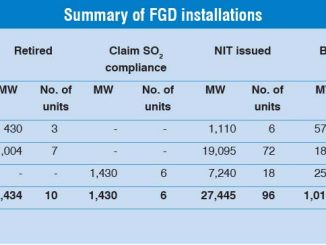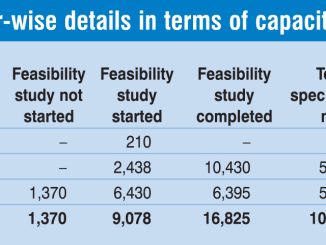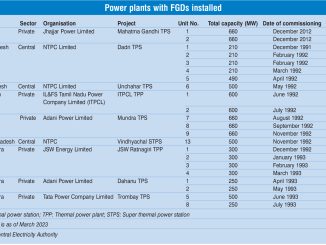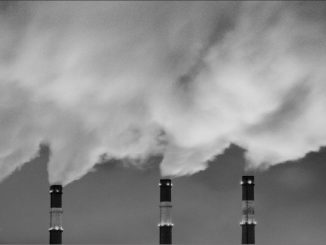
Emission Control


Checks and Balances: Solutions to manage PM and mercury emissions in TPPs
Emission norms Indian coal typically possesses a high ash content ranging from 35 to 42 per cent, accompanied by an average calorific value of 4000 kcal per kg and an average sulphur content of 0.35 […]

Reducing NOx: Current and upcoming technologies to curb emissions
Combustion of coal generates large volumes of nitrogen oxides (NOx), including nitric oxide, nitrogen dioxide and nitrous oxide. The amount of NOx formed depends on combustion conditions and the nitrogen content of the coal. The […]

Reducing SOx Emissions: Progress in FGD implementation
De-SOx technologies play a crucial role in mitigating sulphur dioxide (SO2) emissions from industrial sources, particularly in coal-based power plants. Among these technologies, wet flue gas desulphurisation (FGD) is one of the most popular and […]

Towards Net Zero: Mitigating emissions in coal-based TPPs
Achieving emission control in coal-based thermal power plants (TPPs) is crucial for facilitating a seamless energy transition. Despite the rapid growth of renewable energy capacity, coal-based plants are anticipated to uphold grid stability in the […]

Top Priority: Implementing FGD systems to reduce SOx emissions
Thermal power plants (TPPs) are responsible for large volumes of emissions, making the reduction of pollutants such as SOx, NOx and particulate matter a top priority for power plant operators. Overall compliance with the emission […]

Checking Emissions: Solutions to reduce NOx levels in TPPs
In the ever-evolving area of power generation, attention must be given to mitigating the adverse effects of nitrogen oxides (NOx). NOx emissions, stemming from combustion processes within power plant boilers, present a substantial and pressing […]

Managing PM Emissions: Advanced technologies and mechanisms to reduce pollution levels
Particulate matter (PM) emission from thermal power plants (TPPs) is a key contributor to air pollution. Industry estimates suggest that coal-based TPPs contribute 60 per cent of the total PM emitted. These emissions need to […]



NOX Control Strategies: Key technologies and progress
A significant proportion of the emissions produced by the industrial sector in the country are attributable to the coal-based thermal power industry. The combustion of coal converts the nitrogen bound in it to products such […]

SOX Control: Key considerations for FGD technology selection
For coal-fired power plants, several technology solutions are available to meet the SOX emission standards prescribed by the Ministry of Environment, Forest and Climate Change. Wet FGD based on limestone is one of the most […]

Slow Compliance: Emission control trends and implementation challenges
Coal-based capacity is the largest contributor to power generation in India with a share of around 70 per cent in 2022-23 (till January 2023). The drawback of the higher share of coal-based power generation capacity […]

Combating Pollution: Technologies to control PM and mercury emissions
Besides sulphur oxides (SOx) and nitrogen oxides (NOx), thermal power plants (TPPs) also emit particulate matter (PM) and mercury. These emissions can be reduced by installing suitable emission controlling devices. Various technologies such as electrostatic […]

Handling Effluents: Management of wastewater from FGD systems
Wet flue gas desulphurisation (FGD) systems have been the most popular solution for SOX and NOX emission control, and have been adopted by many thermal power plants (TPPs). More than 90 per cent of TPPs […]

Reducing SOx Emissions: Technologies for minimising the adverse effects of sulphur oxides
Sulphur dioxide (SO2) emissions are a particularly acute problem in the power sector as well as in the country. SO2 is a corrosive gas created by the oxidation of sulphur bearing materials such as coal, […]


Curbing NOx Emissions: Technologies and implementation challenges
While burning coal in the boiler, coal-based thermal power plants (TPPs) convert a large portion of nitrogen in the coal to various forms of nitrogen oxide (NOx) such as nitric oxide, nitrogen dioxide and nitrous […]

Compliance Status: Utility initiatives for emission control
Emission control from coal-based thermal power plants (TPPs) is the key to facilitating a smooth energy transition in India. Renewable energy capacity is growing at a rapid rate and coal-based plants are expected to play […]

Compliance Trends: Recent developments in emission control
Coal-based capacity is the largest contributor to power generation in India with a share of 71 per cent in 2020-21. The drawback of the higher share of coal-based power generation capacity is the emission of […]
